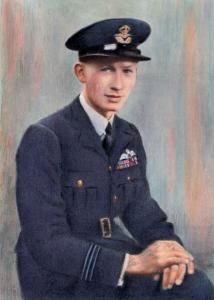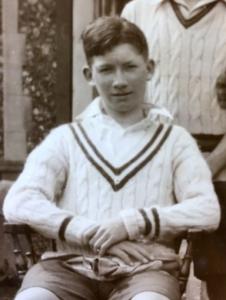
|

|
| Squadron Leader Ian Grahame STEWART (43983) DFC AFC | |
|
65 (East India) Squadron Royal Air Force Date of birth: 13th September 1918 Date of death: 25th March 1945 Killed in action aged 26 Commemorated on the Runnymede Memorial Panel 265 |

|
| Ian Grahame Stewart was born on the 13th of September 1918 the son of Ian Stewart, a banker in Ceylon, and Ivy Kathleen (nee Banks) Stewart of India. He was educated at Lancing College where he was in Sandersons House from September 1932 to July 1936. He was a Sergeant in the Officer Training Corps achieving Certificate A in 1935 and was a member of the Football XI in 1935, the Tennis Team in 1936 and was a member and was Secretary of the Fives Team in the same year. He gained his School Certificate in 1935. He was commissioned as a 2nd Lieutenant in the Royal Artillery (Territorial Army) on the 6th of May 1939 but transferred to the Royal Air Force and was commissioned as a Pilot Officer on probation on the 1st of July 1940. He was promoted to Flying Officer on the 1st of July 1941 and to Flight Lieutenant on the 1st of August 1942. He was awarded the Distinguished Flying Cross while serving with 225 Squadron in North Africa which was announced by the Air Ministry on the 16th of February 1943 The citation read:- “In North Africa, Flight Lieutenant Stewart has completed numerous reconnaissance and bombing sorties in support of the army. In the course of these operations, superior forces of enemy fighters were encountered but Flight Lieutenant Stewart, displaying great skill, successfully returned to base with valuable information. His skilful and courageous work has set a splendid example.” He was also awarded the Air Force Cross while he was serving with 41 Operational Training Unit which was announced by the Air Ministry on the 3rd of April 1945. He was twice mentioned in despatches, which were announced in the London Gazettes of the 1st of January 1945 and of the 3rd of April 1945. He was promoted to Acting Squadron Leader on the 1st of January 1945 and was appointed to command 65 Squadron, based at RAF Peterhead, the same month. At 8.40am on the morning of the 24th of March 1945 Lieutenant Nodeland, who was flying a Mosquito over the Norwegian coast, spotted a tanker and two other vessels in Norangsfjord and radioed back to his base in Banff for an attack on them. 19 and 65 Squadrons were both put on standby to act as escorts for the attack. 235 Squadron was airborne at around 2pm and, having picked up their escort from 19 Squadron, crossed the North Sea and sighted the enemy shipping at 3.43pm. Four minutes later nine of the Mosquitos attacked the convoy, causing damage to the merchantmen, but not sinking them. A second strike was planned, as new intelligence was received that there was a German tanker sheltering at Sognefjord. 24 Mosquitos of 248 and 143 Squadron took off at 1.44pm and picked up their escort of P51 Mustangs from 65 Squadron over Fraserburgh. 65 Squadron was led by Ian Stewart who was flying P51 Mustang Mark IV rKH732. When they arrived in the area they could not locate the German tanker despite a twenty minute search of the area. During this time the Luftwaffe scrambled 30 FW 190s from their base at Herdla to intercept the raiders, which they did, at 3,000 feet over Sognefjord. The Mustangs of 65 Squadron were flying top cover at 5,000 feet and on sighting the hostile FW190s they jettisoned their drop tanks and dived to the attack. There were around 60 aircraft from both sides in one enormous dogfight during which Ian Stewart became detached from the main force and became engaged in a fight with two 190s flown by Oberleutnant Fritz Kohrt, the Commanding Officer of JG5 and a veteran of the Russian front, and his wingman Leutnant Eberhard Lemmel a relative novice who had received his wings the previous November. In his combat report after the action Lemmel wrote the following:- "We were scrambled from Herdla to engage a large force under direction of the radar on Fedje Island. I was flying FW190-8 numbered Blau 4 and flew as number two to my Staffelkaptain Oberleutnant Fritz Kohrt. We were being directed by System "Y", which meant I was unable to transmit on the radio. When we became engaged in combat a Mustang pilot shot down Kohrt, but in the battle I had manoeuvred into a favourable position behind the Mustang and shot it down in turn. The aircraft flew straight into the sea and I returned to Herdla." Lemmel recorded the time Stewart's aircraft as crashing at 3.57pm and that he was at a height of 700 metres when he brought it down. In addition to Stewart's aircraft, two Mosquitos were lost but five FW190s were claimed in reply. He was married to Kathleen Mary (nee Tremain), of Alverstoke, Hampshire. They had a daughter, Anna, born on the 27th of October 1942. |
|
 | |
| Sandersons House |
Back